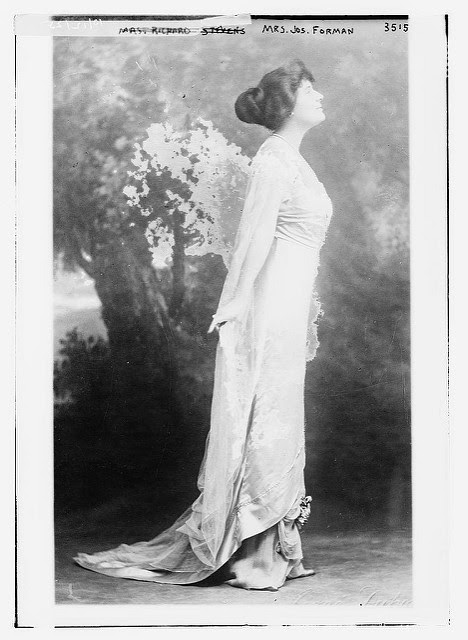Teach This Poem is a weekly series featuring a poem from our online poetry collection, accompanied by interdisciplinary resources and activities designed to help K-12 teachers quickly and easily bring poetry into the classroom.

From the George Grantham Bain Collection, Library of Congress, Prints and Photographs Division, Washington, D.C. 20540 USA.
The following activities and questions are designed to help your students use their noticing skills to move through the poem and develop their thinking about its meaning with confidence, using what they’ve noticed as evidence for their interpretations. Read more about the framework upon which these activities are based.
-
Warm-up (whip around): Ask a question that can’t be easily or accurately answered. (This can be a silly or a serious question.)
-
Before Reading the Poem (individual writing and pair share): Look carefully at the photograph of the woman in a long dress. Write down what you notice, including the color and shape of the dress, as well as any questions this image prompts you to ask. Share these notes with a partner.
-
Reading the Poem: Read the excerpt of Gertrude Stein’s Tender Buttons silently, then write down the words and phrases that jump out at you.
-
Listening to the Poem (enlist two volunteers to read the poem aloud): Listen as the poem is read aloud twice and write down any additional words and phrases that you notice.
-
Small-group Discussion: Share the words, phrases, and questions you wrote down during the warm-up and the poem. Make a list of the two or three most pressing questions to discuss among yourselves and with the class.
-
Whole-class Discussion: What are the questions you noticed in the poem? What questions do you have about these questions? Is the poem a simple description of a long dress? How does it differ from a simple description? What, in the poem, does not make sense to you? Why do you think the poet might have written these phrases and lines?
-
Extension for Grades 7-8: Write a poem that “describes” something using only questions and answers. Add some words and phrases that sound good to you but might not make sense. Present your poem in a reading to your classmates.
-
Extension for Grades 9-12: Read the biography of Gertrude Stein on Poets.org, then look at an image of Pablo Picassso’s cubist painting Seated Man. In what ways might Stein’s poem reflect the type of image Picasso created? Write an essay that compares and contrasts the poem with the painting.
More Context for Teachers: “Unlike her contemporaries (Eliot, Pound, Moore), [Gertrude Stein] does not give us an image, however fractured, of a carafe on a table; rather, she forces us to reconsider how language actually constructs the world we know.” Read the essay “The Difference is Spreading: on Gertrude Stein.”
